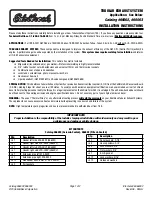
Checking and refilling levels
–
Cover the coolant expansion tank cap with
a cloth and carefully unscrew it to the left
–
Top up the coolant only if there is still cool-
ant in the expansion tank, otherwise you
could
damage the engine
. If there is no
coolant in the expansion tank, do not con-
tinue driving. You should obtain professional
assistance
–
If there is still some coolant in the expansion
tank, top up to the upper mark.
–
Top up with coolant until the level becomes
stable.
–
Screw the cap back on correctly.
If there is a coolant leak, take the vehicle spe-
cialised workshop to have the cooling system
examined.
WARNING
●
The cooling system is under pressure. Do
not unscrew the cap on the coolant expan-
sion tank when the engine is hot: risk of
burns!
●
Store the antifreeze in its original con-
tainer and keep it out of reach of children.
●
If working inside the engine compart-
ment, remember that, even when the igni-
tion is switched off, the radiator fan may
start up automatically, and therefore there
is a risk of injury.
CAUTION
If you run out of coolant in the expansion
tank, park the car in a safe place and do
not continue driving. Obtain technical as-
sistance.
Brake fluid
Check and refill the brake fluid
Fig. 226
Engine compartment: brake fluid res-
ervoir cap.
The brake fluid reservoir is located in the en-
gine compartment
.
Checking the brake fluid level
The brake fluid level must be between the
and
markings.
However, if the brake fluid level goes down
noticeably in a short time, or drops below the
mark, there may be a leak in the brake
system. Seek specialist assistance. A warning
light on the instrument panel display monitors
the brake fluid level
.
In right-hand drive vehicles the brake fluid
reservoir is on the other side of the engine
compartment.
Changing brake fluid
We recommend that you have the brake fluid
changed by a Technical Service.
WARNING
If the brake fluid level is low or unsuita-
ble/old brake fluid is used, the brake sys-
tem may fail or braking power may be re-
duced.
●
Check the brake system and the brake
fluid level regularly!
●
When the brake fluid is used and brakes
are subjected to extreme braking forces,
bubbles of vapour form in the brake sys-
tem. These bubbles can significantly re-
duce braking power, notably increasing
braking distance, and could result in the to-
tal failure of the brake system.
●
Be sure to always use the correct brake
fluid. Only use brake fluid that expressly
meets the VW 501 14 standard.
»
319
Summary of Contents for Ateca 2020
Page 1: ...Ateca Owner s manual 575012720BP Ingl s 575012720BP 07 20 SEAT Ateca Ingl s 07 20...
Page 6: ......
Page 70: ...Operation Fig 66 Instruments and controls 68...
Page 357: ...Indications about the technical data Dimensions Fig 235 Dimensions 355...
Page 374: ......
Page 376: ...Ateca Owner s manual 575012720BP Ingl s 575012720BP 07 20 SEAT Ateca Ingl s 07 20...
















































